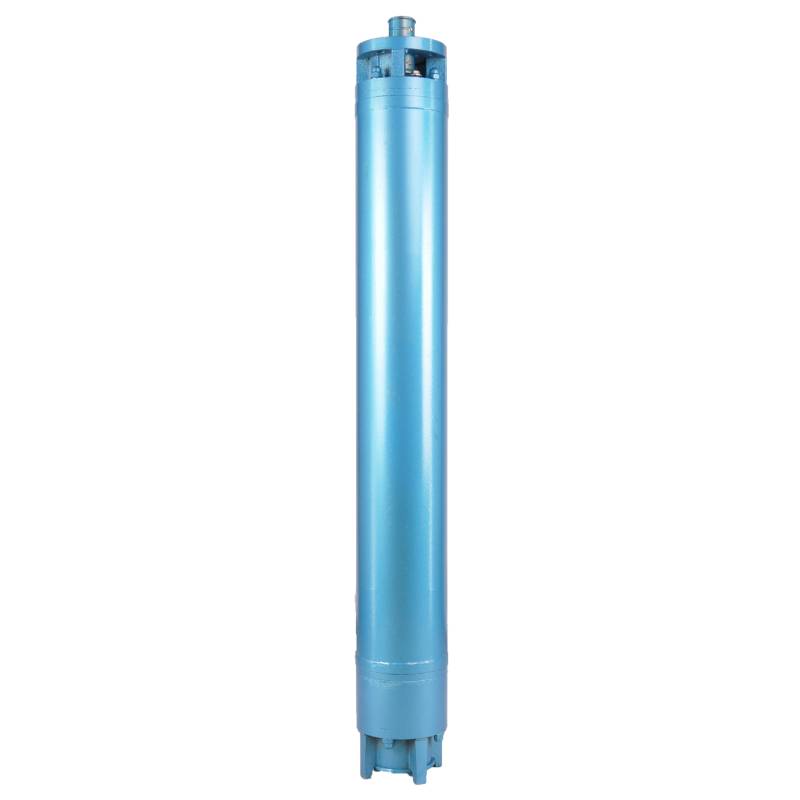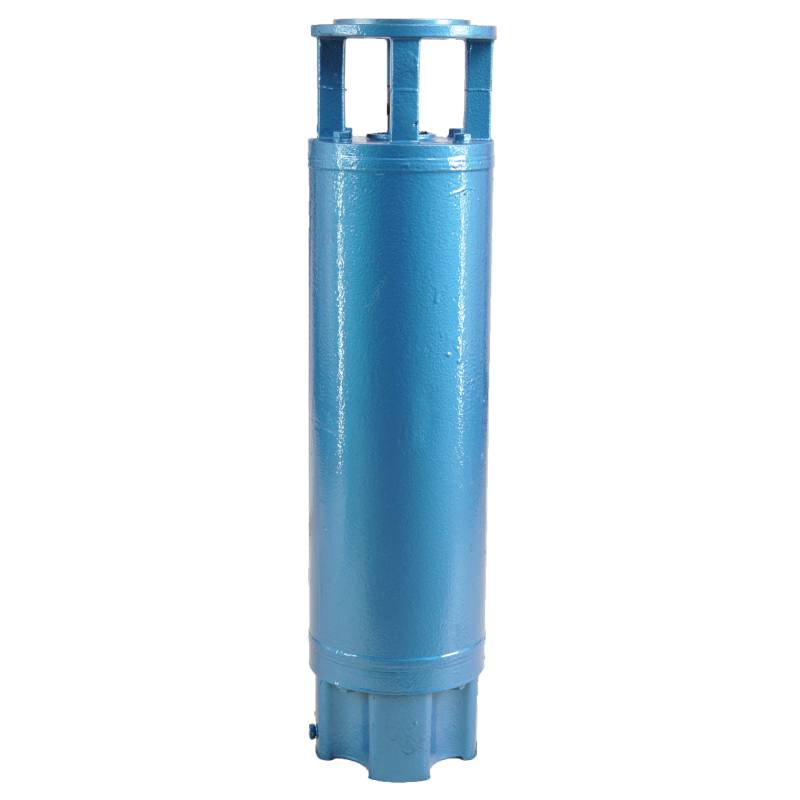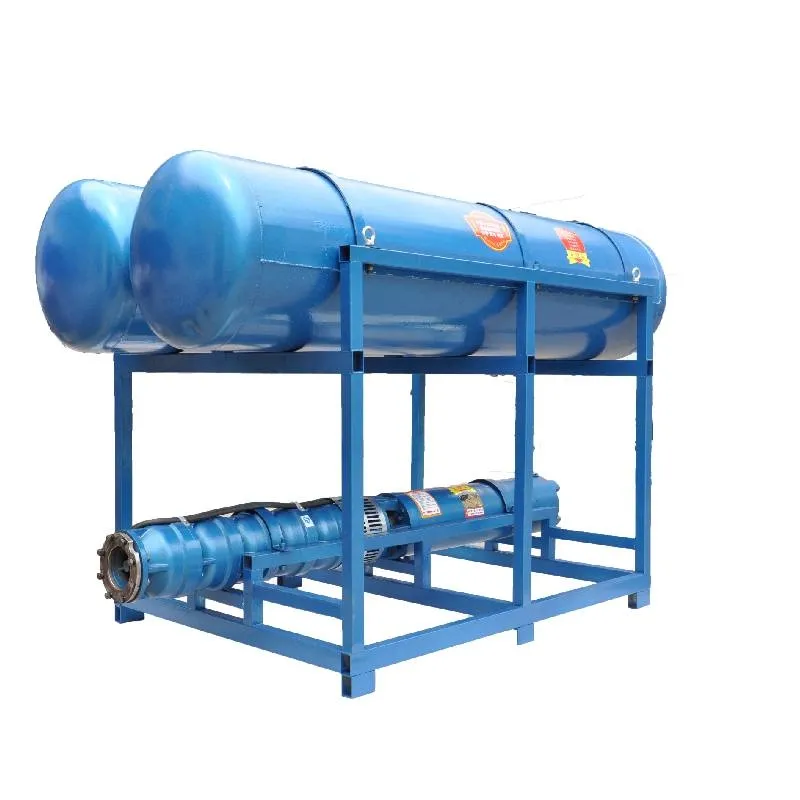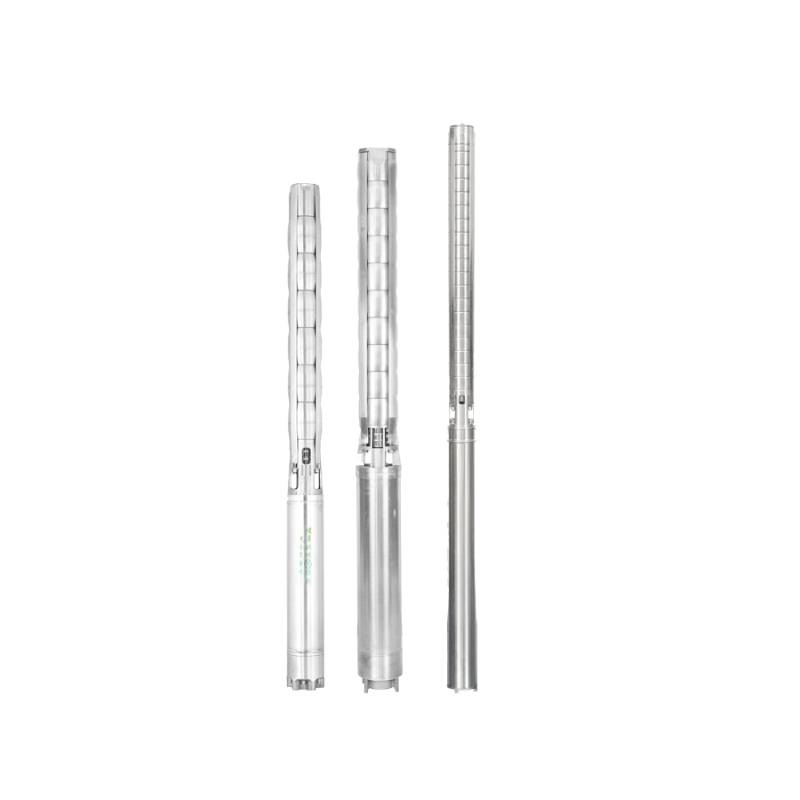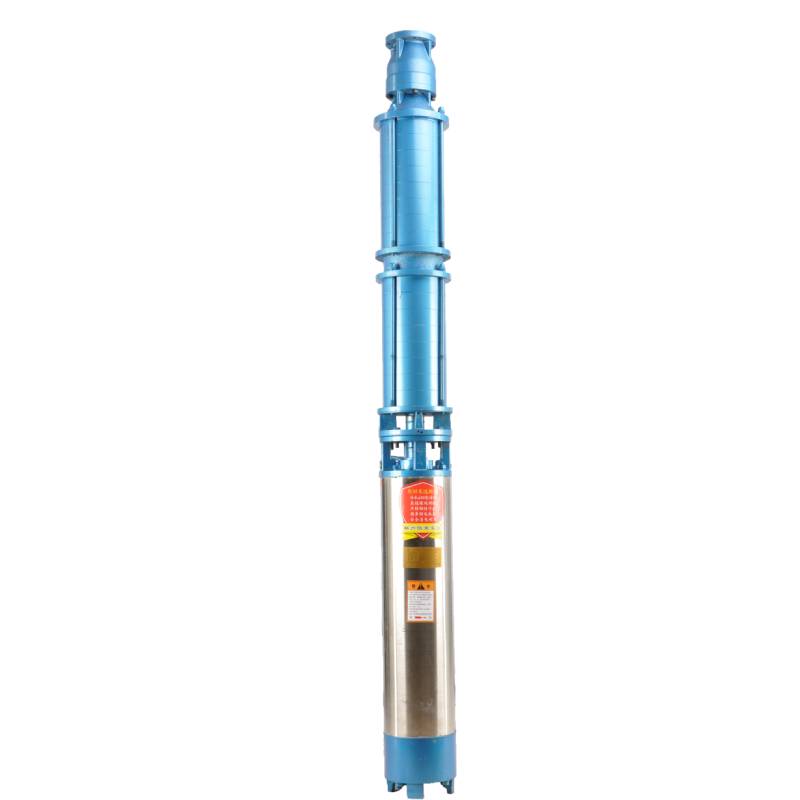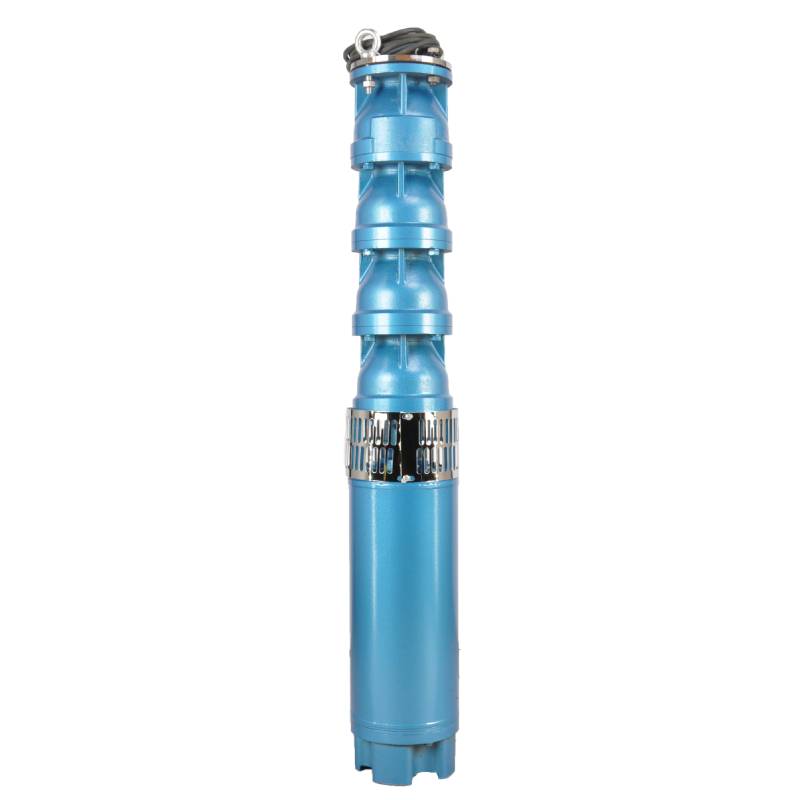This product is designed for underground hot water mining and is suitable for water temperatures below 100°C. It has high temperature resistance, corrosion resistance and aging resistance. This product is very suitable for use in underground hot water mining environments, which can effectively deal with high temperatures and corrosion of various chemical substances, while having good aging resistance, ensuring stable operation of equipment for a long time. Whether it is needed to be used in harsh mining environments or in the face of high water temperatures, this product can provide reliable protection, ensuring continuous operation and efficient work of equipment.
Product introduction: we recommend this product is equipped with three-phase AC 380V (tolerance + / - 1%), 50HZ (tolerance + / - 1%) power supply. Water quality requirements are strict, the water temperature shall not be higher than 20 °C, the content of solid impurities (mass ratio) shall not be greater than 0.01%; PH value (pH) between 6.5-8.5; hydrogen sulfide content shall not be greater than 1.5mg/L; chloride ion content shall not exceed 400mg/L. The product is equipped with a closed or water-cooled wet structure motor. Before use, the inner cavity of the submersible motor shall be filled with clean water to prevent empty. Then tighten the water injection and air exhaust screws, otherwise it is prohibited to use. The submersible pump must be completely immersed in water to operate, the penetration depth shall not exceed 70 meters, and the distance between the bottom of the submersible pump and the bottom of the well shall not be less than 3 meters. The inflow of well water shall meet the water output and continuous operation requirements of the submersible pump, and the water output of the pump shall be controlled between 0.7 and 1.2 times the rated flow. The well must be vertical, and the submersible pump can not be used horizontally or dumped, but only vertically. The submersible pump must be equipped with cables as required, and is equipped with external overload protection device. It is prohibited to test the pump without water and no load.
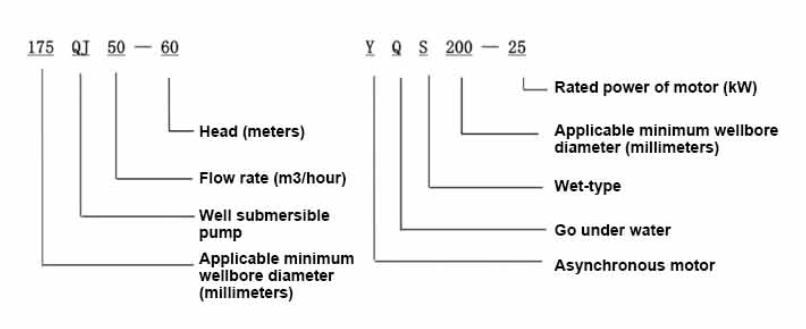
| Hoʻohālike | Kahe (m3/h) | Poʻo (m) |
Holoi wikiwiki (hoʻololi / kiko) |
Pum wai(%) | puka puka anawaena (mm) |
Kūpono maikaʻi anawaena(mm) |
Heluhelu ʻia power(KW) |
Heluhelu ʻia uila (V) |
Heluhelu ʻia kēia manawa(A) |
Kaʻa kaʻa (%) | power factorcosφ | Unite Ka nui o ka Radial (mm) |
|||||||||
| 175QJ10-42 | 10 | 42 | 2850 | 53 | 50 | 175maluna | 3 | 380 | 7.8 | 74.0 | 0.79 | 168 | |||||||||
| 175QJ10-56 | 56 | 4 | 10.1 | 76.0 | 0.79 | ||||||||||||||||
| 175QJ10-70 | 70 | 4 | 10.1 | 76.0 | 0.79 | ||||||||||||||||
| 175QJ10-84 | 84 | 5.5 | 13.6 | 77.0 | 0.8 | ||||||||||||||||
| 175QJ10-112 | 112 | 7.5 | 18.4 | 77.5 | 0.8 | ||||||||||||||||
| 175QJ10-126 | 126 | 7.5 | 18.4 | 77.5 | 0.8 | ||||||||||||||||
| 175QJ10-140 | 140 | 9.2 | 22.1 | 78.0 | 0.81 | ||||||||||||||||
| 175QJ15-42 | 15 | 42 | 2850 | 58 | 50 | 175maluna | 4 | 380 | 10.1 | 76.0 | 0.79 | 168 | |||||||||
| 175QJ15-55 | 55 | 5.5 | 13.6 | 77.0 | 0.8 | ||||||||||||||||
| 175QJ15-65 | 65 | 5.5 | 13.6 | 77.0 | 0.8 | ||||||||||||||||
| 175QJ15-85 | 85 | 7.5 | 18.4 | 77.5 | 0.8 | ||||||||||||||||
| 175QJ15-112 | 112 | 9.2 | 22.1 | 78.0 | 0.81 | ||||||||||||||||
| 175QJ20-26 | 20 | 26 | 2850 | 64 | 50 | 175maluna | 3 | 380 | 7.8 | 74.0 | 0.79 | 168 | |||||||||
| 175QJ20-39 | 39 | 4 | 10.1 | 76.0 | 0.79 | ||||||||||||||||
| 175QJ20-52 | 52 | 5.5 | 13.6 | 77.0 | 0.8 | ||||||||||||||||
| 175QJ20-78 | 78 | 7.5 | 18.4 | 77.5 | 0.8 | ||||||||||||||||
| 175QJ20-91 | 91 | 9.2 | 22.1 | 78.0 | 0.81 | ||||||||||||||||
| 175QJ20-104 | 104 | 11 | 26.1 | 79.0 | 0.81 | ||||||||||||||||
| 175QJ20-130 | 130 | 13 | 30.1 | 80.0 | 0.82 | ||||||||||||||||
| 175QJ20-156 | 156 | 15 | 34.7 | 80.0 | 0.82 | ||||||||||||||||
| 175QJ20-182 | 187 | 18.5 | 42.6 | 80.5 | 0.82 | ||||||||||||||||
| 175QJ20-208 | 208 | 22 | 49.7 | 81.0 | 0.83 | ||||||||||||||||
| 175QJ20-247 | 247 | 25 | 56.5 | 81.0 | 0.83 | ||||||||||||||||
| 175QJ20-273 | 273 | 30 | 66.6 | 81.5 | 0.84 | ||||||||||||||||
| 175QJ20-299 | 299 | 30 | 66.6 | 81.5 | 0.84 | ||||||||||||||||
| 175QJ20-325 | 325 | 32 | 71.0 | 81.5 | 0.84 | ||||||||||||||||
| 175QJ20-364 | 364 | 37 | 82.1 | 81.5 | 0.84 | ||||||||||||||||
| 175QJ25-26 | 25 | 26 | 2850 | 66 | 65 | 175maluna | 3 | 380 | 7.8 | 74.0 | 0.79 | 168 | |||||||||
| 175QJ25-39 | 39 | 5.5 | 13.6 | 77.0 | 0.8 | ||||||||||||||||
| 175QJ25-65 | 25 | 65 | 2850 | 66 | 65 | 175maluna | 7.5 | 380 | 18.4 | 77.5 | 0.8 | 168 | |||||||||
| 175QJ25-78 | 78 | 9.2 | 22.1 | 78.0 | 0.81 | ||||||||||||||||
| 175QJ25-91 | 91 | 11 | 26.1 | 79.0 | 0.81 | ||||||||||||||||
| 175QJ25-104 | 104 | 13 | 30.1 | 80.0 | 0.82 | ||||||||||||||||
| 175QJ25-130 | 130 | 15 | 34.7 | 80.0 | 0.82 | ||||||||||||||||
| 175QJ25-156 | 156 | 18.5 | 42.6 | 80.5 | 0.82 | ||||||||||||||||
| 175QJ25-182 | 182 | 22 | 49.7 | 81.0 | 0.83 | ||||||||||||||||
| 175QJ25-208 | 208 | 25 | 56.5 | 81.0 | 0.83 | ||||||||||||||||
| 175QJ25-221 | 221 | 30 | 66.6 | 81.5 | 0.84 | ||||||||||||||||
| 175QJ25-247 | 247 | 30 | 66.6 | 81.5 | 0.84 | ||||||||||||||||
| 175QJ25-260 | 260 | 32 | 71.0 | 81.5 | 0.84 | ||||||||||||||||
| 175QJ25-299 | 299 | 37 | 82.1 | 81.5 | 0.84 | ||||||||||||||||
| 175QJ30-30 | 30 | 30 | 2850 | 67 | 80 | 175maluna | 4 | 380 | 10.1 | 76.0 | 0.79 | 168 | |||||||||
| 175QJ30-40 | 40 | 5.5 | 13.6 | 77.0 | 0.8 | ||||||||||||||||
| 175QJ32-24 | 32 | 24 | 2850 | 67 | 80 | 175maluna | 4 | 380 | 10.1 | 76.0 | 0.79 | 168 | |||||||||
| 175QJ32-36 | 36 | 5.5 | 13.6 | 77.0 | 0.8 | ||||||||||||||||
| 175QJ32-48 | 48 | 7.5 | 18.4 | 77.5 | 0.8 | ||||||||||||||||
| 175QJ32-60 | 60 | 9.2 | 22.1 | 78.0 | 0.81 | ||||||||||||||||
| 175QJ32-72 | 72 | 11 | 26.1 | 79.0 | 0.81 | ||||||||||||||||
| 175QJ32-84 | 84 | 13 | 30.1 | 80.0 | 0.82 | ||||||||||||||||
| 175QJ32-96 | 96 | 15 | 34.7 | 80.0 | 0.82 | ||||||||||||||||
| 175QJ32-120 | 120 | 18.5 | 42.6 | 80.5 | 0.82 | ||||||||||||||||
| 175QJ32-144 | 144 | 22 | 49.7 | 81.0 | 0.83 | ||||||||||||||||
| 175QJ32-168 | 168 | 25 | 56.5 | 81.0 | 0.83 | ||||||||||||||||
| 175QJ32-180 | 180 | 30 | 66.6 | 81.5 | 0.84 | ||||||||||||||||
| 175QJ32-192 | 192 | 30 | 66.6 | 81.5 | 0.84 | ||||||||||||||||
| 175QJ32-204 | 204 | 32 | 71.0 | 81.5 | 0.84 | ||||||||||||||||
| 175QJ32-240 | 240 | 37 | 82.1 | 81.5 | 0.84 | ||||||||||||||||
| 175QJ35-60 | 35 | 60 | 2850 | 67 | 80 | 175maluna | 10 | 380 | 25.0 | 78.0 | 0.78 | 168 | |||||||||
| 175QJ35-75 | 75 | 13 | 30.1 | 80.0 | 0.82 | ||||||||||||||||
| 175QJ35-100 | 100 | 17 | 40.9 | 80.0 | 0.79 | ||||||||||||||||
| 175QJ40-24 | 40 | 24 | 2850 | 70 | 80 | 175maluna | 5.5 | 380 | 13.6 | 77.0 | 0.8 | 168 | |||||||||
| 175QJ40-30 | 30 | 5.5 | 13.6 | 77.0 | 0.8 | ||||||||||||||||
| 175QJ40-36 | 36 | 7.5 | 18.4 | 77.5 | 0.8 | ||||||||||||||||
| 175QJ40-48 | 48 | 9.2 | 22.1 | 78.0 | 0.81 | ||||||||||||||||
| 175QJ40-60 | 60 | 11 | 26.1 | 79.0 | 0.81 | ||||||||||||||||
| 175QJ40-72 | 72 | 13 | 30.1 | 80.0 | 0.82 | ||||||||||||||||
| 175QJ40-84 | 84 | 15 | 34.7 | 80.0 | 0.82 | ||||||||||||||||
| 175QJ40-96 | 96 | 18.5 | 42.6 | 80.5 | 0.82 | ||||||||||||||||
| 175QJ40-120 | 120 | 22 | 49.7 | 81.0 | 0.83 | ||||||||||||||||
| 175QJ40-132 | 132 | 25 | 56.5 | 81.0 | 0.83 | ||||||||||||||||
| 175QJ40-144 | 144 | 30 | 66.6 | 81.5 | 0.84 | ||||||||||||||||
| 175QJ40-156 | 156 | 30 | 66.6 | 81.5 | 0.84 | ||||||||||||||||
| 175QJ40-168 | 168 | 32 | 71.0 | 81.5 | 0.84 | ||||||||||||||||
| 175QJ40-192 | 192 | 37 | 82.1 | 81.5 | 0.84 | ||||||||||||||||
| 175QJ50-24 | 50 | 24 | 2850 | 72 | 80 | 175maluna | 5.5 | 380 | 13.6 | 77.0 | 0.8 | 168 | |||||||||
| 175QJ50-36 | 36 | 9.2 | 22.1 | 78.0 | 0.81 | ||||||||||||||||
| 175QJ50-48 | 48 | 11 | 26.1 | 79.0 | 0.81 | ||||||||||||||||
| 175QJ50-60 | 60 | 13 | 30.1 | 80.0 | 0.82 | ||||||||||||||||
| 175QJ50-70 | 70 | 17 | 40.9 | 80.0 | 0.79 | ||||||||||||||||
| 175QJ50-84 | 84 | 18.5 | 42.6 | 80.5 | 0.82 | ||||||||||||||||
| 175QJ50-96 | 96 | 22 | 49.7 | 81.0 | 0.83 | ||||||||||||||||
| 175QJ50-108 | 108 | 25 | 56.5 | 81.0 | 0.83 | ||||||||||||||||
| 175QJ50-120 | 120 | 30 | 66.6 | 81.5 | 0.84 | ||||||||||||||||
| 175QJ50-132 | 132 | 30 | 66.6 | 81.5 | 0.84 | ||||||||||||||||
| 175QJ50-144 | 144 | 32 | 71.0 | 81.5 | 0.84 | ||||||||||||||||
| 175QJ50-156 | 156 | 37 | 82.1 | 81.5 | 0.84 | ||||||||||||||||
| 175QJ63-22 | 63 | 22 | 2850 | 72 | 80 | 175maluna | 7.5 | 380 | 18.4 | 77.5 | 0.8 | 168 | |||||||||
| 175QJ63-44 | 44 | 13 | 30.1 | 80.0 | 0.82 | ||||||||||||||||
| 175QJ63-55 | 55 | 15 | 34.7 | 80.0 | 0.82 | ||||||||||||||||
| 175QJ63-66 | 66 | 18.5 | 42.6 | 80.5 | 0.82 | ||||||||||||||||
| 175QJ63-77 | 77 | 22 | 49.7 | 81.0 | 0.83 | ||||||||||||||||
| 175QJ63-88 | 88 | 25 | 56.5 | 81.0 | 0.83 | ||||||||||||||||
| 175QJ63-99 | 63 | 99 | 2850 | 72 | 80 | 175maluna | 30 | 380 | 66.6 | 81.5 | 0.84 | 168 | |||||||||
| 175QJ63-110 | 110 | 32 | 71.0 | 81.5 | 0.84 | ||||||||||||||||
| 175QJ63-132 | 132 | 37 | 82.1 | 81.5 | 0.84 | ||||||||||||||||
| 175QJ80-9 | 80 | 9 | 2850 | 73 | 100 | 175maluna | 4 | 380 | 10.1 | 76.0 | 0.79 | 168 | |||||||||
| 175QJ80-18 | 18 | 7.5 | 18.4 | 77.5 | 0.8 | ||||||||||||||||
| 175QJ80-27 | 27 | 11 | 26.1 | 79.0 | 0.81 | ||||||||||||||||
| 175QJ80-36 | 36 | 15 | 34.7 | 80.0 | 0.82 | ||||||||||||||||
| 175QJ80-45 | 45 | 18.5 | 42.6 | 80.5 | 0.82 | ||||||||||||||||
| 175QJ80-54 | 54 | 22 | 49.7 | 81.0 | 0.83 | ||||||||||||||||
| 175QJ80-63 | 63 | 25 | 56.5 | 81.0 | 0.83 | ||||||||||||||||
| 175QJ80-72 | 72 | 25 | 56.5 | 81.0 | 0.83 | ||||||||||||||||
| 175QJ80-81 | 81 | 30 | 66.6 | 81.5 | 0.84 | ||||||||||||||||
| 175QJ80-90 | 90 | 32 | 71.0 | 81.5 | 0.84 | ||||||||||||||||
| 175QJ80-98 | 98 | 37 | 82.1 | 81.5 | 0.84 | ||||||||||||||||
1, well submersible pump for clean water pump, prohibit the new well, pumping sediment and muddy water,
2, well water pump voltage grade of 380/50HZ, the use of other voltage grades of submersible motors need to be customized. The underground cable must use waterproof cable, must be equipped with starting equipment, such as distribution box, start not ready should have commonly used motor comprehensive protection function, such as short circuit overload protection, phase protection, undervoltage protection, grounding protection, idling protection, in case of abnormal conditions, the protection device should be timely action trip.
3, the installation and use of the pump must be reliably grounded, prohibit the push and pull switch when the hands and feet are wet, the installation and maintenance of the pump must be cut off the power supply, the use of the pump place to set up "to prevent electric shock" obvious signs:
4, down the well or before installation, the motor cavity must be filled with distilled water or non-corrosive clean cold boiling water, tighten the / water bolt, the pump on the ground test run, must be to the pump chamber water lubrication rubber bearings, instant start not more than a second, see whether the steering is the same as the steering instructions. When the pump is upright, pay attention to safety, prevent overturning injury.
5, e like me nā ʻōlelo o ka hoʻokiʻekiʻe ʻana o ka pauma, ke kahe o ka hoʻohana ʻana, e pale i ke kahe haʻahaʻa a i ʻole ka hoʻokiʻekiʻe kiʻekiʻe o ka pumping ikaika, ke kuʻi ʻana a me nā ʻāpana ʻē aʻe o ka ʻaʻahu, ua wela ke kaʻa.
6, after the pump down the well, the measurement of the motor to the ground insulation resistance should not be less than 100M, after the start to observe the voltage and current, check the motor winding insulation, whether in line with the requirements; pump storage location temperature if less than freezing point, should be dry the motor cavity water, prevent the motor cavity water ice damage caused by low temperature.
ʻO ka hoʻomaka pōkole o ka hoʻolālā: ʻo ka ʻaoʻao pauma ka mea nui i haku ʻia me ka pahu paila, impeller, diversion shell, rubber bearing, check valve body (koho koho) a me nā mea ʻē aʻe. , noho alakaʻi alakaʻi haʻahaʻa, stator, rotor, alakaʻi alakaʻi luna noho, apo one, ʻāpana wai komo, kaula a me nā mea ʻē aʻe.
ʻO nā hiʻohiʻona nui o ka huahana:
1, ʻO ke kaʻa he wai piha piha i ka wai submersible ʻekolu-phase asynchronous motor, piha ka pahu kaʻa i ka wai maʻemaʻe, hoʻohana ʻia e hōʻoluʻolu i ka mīkini a lubricate i ka bearing, hoʻohana ʻia ke kiʻi hoʻoponopono kaomi ma lalo o ka kaʻa e hoʻoponopono. ka hoʻonui a me ka ʻokoʻa o ke kaomi ʻana o ka wai i loko o ke kino ma muli o ka hoʻololi ʻana o ka piʻi ʻana o ka wela o ke kaʻa.
2, I mea e pale aku ai i ke one i loko o ka wai punawai mai ke komo ʻana i ke kaʻa, ua hoʻolako ʻia ka ʻaoʻao o luna o ka pahu kaʻa me nā sila ʻaila ʻelua, a ua hoʻokomo ʻia kahi apo one e hana i kahi ʻano pale one.
3, I mea e pale ʻole ai i ka holo ʻana o ka pahu pāpaʻi i ka wā e hoʻomaka ai, ua hoʻopili ʻia ka pahu pāpaʻi a me ka pahu kaʻa e ka hui ʻana, a ua hoʻokomo ʻia kahi pahu pahu kiʻekiʻe ma ka ʻaoʻao haʻahaʻa o ke kaʻa.
4, ʻO ka lubrication o ka kaʻa a me ka pahū pahū he wai lubrication.
5, Hana ʻia ka wili kaʻa kaʻa stator me ke ʻano kiʻekiʻe o ka submersible motor winding wire, me ka hana insulation kiʻekiʻe.
6, Hoʻolālā ʻia ka paila e ka CAD kamepiula, me ka hana maʻalahi a me ka hana ʻenehana maikaʻi.

(1) Hoʻomākaukau ma mua o ke kau ʻana:
1. E nānā inā kūpono ka pauma submersible i nā kūlana hoʻohana a me ka laulā i ʻōlelo ʻia ma ka manual.
2. Ma ka hoʻohana ʻana i kahi obiect kaumaha me ke anawaena e like me ke anawaena o waho loa o ka pauma hoʻohaʻahaʻa, e ana inā hiki i ka inneldiameter o ka luawai ke hoʻokomo i ka pauma hoʻoheheʻe ʻia, a e ana i ka hoʻokō ʻana o ka hohonu i nā koi hoʻokomo.
3. E nānā i ka maʻemaʻe o ka luawai a me ka wai o ka pūnāwai. Mai hoʻohana i ka pauma uila e holoi ai i ka ʻōpala welor a me ka wai one no ka pale ʻana i ka pōʻino mua o ka pauma uila.
4. E nānā inā kūpono ke kūlana o ka hoʻopili welhead a inā hiki iā ia ke kū i ke kūlana o ka ʻāpana holoʻokoʻa.
5. E nānā inā ua paʻa a hoʻokomo pono ʻia nā ʻāpana pauma submersible e like me ke kiʻikuhi hui ma ka manual.
6. Wehe i ka wili wai a hoʻopiha i ka lua kaʻa me ka wai maʻemaʻe, ʻaʻole ʻino (e hoʻomaopopo. Ma hope o 12 mau hola o ka wai ʻana, ʻaʻole pono e emi ka pale insulation o ke kaʻa ma mua o 150M Q ke ana ʻia me kahi papa haʻalulu 500V.
7. Cable joint, cut off a 120mm rubber sleeve from one end of the outgoing cable and the matching cable with an electrician's knifethen stagger the length of the three core wires in a stepped shape, peel off a 20mm copper core, scrape of the oxide layer on theoutside of the copper wire with a knife or sand cloth, and insert the two connected wire ends in palirs.After tying the layer tightly with fine copper wire, solder it thoroughly and firmly, and sand of any. burrs on the surface. Then, forthe three joints, use polyvester insulation tape to wrap them in a semi stacked manner for three lavers. Wrap the two ends of thewrapping layer tightywith nyion thread,and then use a semi stacked method to wrap the tape for three layers. Wrap the outellayer with high-pressure insulation tape for three layers. Finally, fold the threestrands together and repeatedly wrap them for fivelayers with high-pressure tape. Each layer must be tightly tied, and the interlayer joints must be tight and fimm to prevent water frompenetrating and damaging the insulation, After wrapping, soak in water at room temperature of 20 ’c for 12 hours, and measurethe insulation resistance with a shaking table, which should not be less than 100M Ω
ʻO ke kiʻikuhi kaʻina hana uwila i hoʻopili ʻia penei:
8. E hoʻohana i ka multimeter no ka nānā ʻana inā pili ʻia nā uea ʻekolu ʻāpana a inā ʻaʻole kaulike ke kūpaʻa DC.
9. E nānā inā ua hoʻonui ʻia ka mana kaapuni a me ka mea hoʻololi, a laila hoʻohui i ke kī hoʻomalu overload a i ʻole nā mea hoʻomaka. E nānā i ka Papa 2 no nā hi'ohi'ona kiko'ī, a laila, e ninini i ka bākeke wai i loko o ka pā wai mai ka puka wai e ho'oma'ama'a i ka pahu pahu i loko o ka pama, a laila e kau i ka pauma uwila i lalo i luna a pa'a. a e nānā inā pili ka hoʻokele me ka hōʻailona hoʻokele. Inā ʻaʻole, e hoʻololi i nā mea hoʻohui ʻelua o ke kaula ʻekolu. Inā hoʻohana ʻia i nā hanana kūikawā (e like me nā ʻauwai, nā ʻauwai, nā muliwai, nā loko, nā loko, a me nā mea ʻē aʻe), pono e hoʻopaʻa ʻia ka paila uila.
(2) Mea hoʻokomo a me nā mea hana:
1. Hoʻokahi mau kaulahao hāpai no ʻelua mau tona.
2. ʻO kahi tripod me ke kiʻekiʻe kū i lalo o ʻehā mau mika.
3. ʻElua kaula kau (wire ropes) hiki ke kaumaha i ke kaumaha ma mua o hoʻokahi tona (hiki ke halihali i ke kaumaha o ka pahu wai piha).
4. E hoʻouka i ʻelua mau paʻi (splints).
5. Nā wrenches, hammers, screwdrivers, uila a me nā mea kani, etc.
(3) Hoʻokomo ʻia ka pauma uila:
1. Hōʻike ʻia ke kiʻikuhi hoʻonohonoho o ka pauma uila submersible ma ka Figure 2. Hōʻike ʻia nā ana hoʻonohonoho kikoʻī ma ka Papa 3 "List of Installation Dimensions of the Submersible Electric Pump".
2. Hiki ke hoʻokiʻekiʻe pololei ʻia nā paila uila me ke poʻo ma lalo o 30 mika i loko o ka pūnāwai me ka hoʻohana ʻana i nā paipu a me nā kaula uwea a i ʻole nā kaula hemp ʻē aʻe e hiki ai ke halihali i ke kaumaha piha o ka mīkini holoʻokoʻa, nā paipu wai, a me ka wai i loko o nā paipu.
3. ʻO nā pumps me ke poʻo i ʻoi aku ma mua o 30 mika e hoʻohana i nā paipu kila, a penei ka hoʻonohonoho ʻana:
①E hoʻohana i kahi pipili no ka hoʻopaʻa ʻana i ka ʻaoʻao o luna o ka ʻaoʻao o ka pauma wai (ua hoʻopili ʻia ke kaʻa a me ka pauma wai i kēia manawa), e hoʻokiʻekiʻe me ke kaulahao e kau ana, a nakinaki mālie i loko o ka luawai a kau i ka paʻi ma ke poʻo punawai a wehe i ke kaulahao. kaulahao e kau ana.
② E hoʻohana i nā paipu ʻē aʻe e hoʻopaʻa i ka paipu, e hoʻokiʻekiʻe me ke kaulahao e kau ana ma kahi mamao o 15 knm mai ka lehelehe, a e hoʻohaʻahaʻa mālie. Ma waena o ka flange paipu a me ka flange pump E hoʻopaʻa i ka pā hao a hoʻopaʻa i ka paipu a paʻa pono me nā bolts, nati a me nā mea holoi puna.
③ E hoʻokiʻekiʻe iki i ka pauma hoʻohaʻahaʻa, e wehe i ke kaula ma ka ʻaoʻao o luna o ka pā wai, e hoʻopaʻa paʻa i ke kaula i ka paipu wai me ka lipine plastik, a nakinaki mālie i lalo a kau ʻia ka paʻi ma ka luawai.
④E hoʻohana i ke ʻano like e hoʻopaʻa ai i nā paipu wai a pau i loko o ka pūnāwai.
⑤Ma hope o ka hoʻopili ʻia ʻana o ke kaula alakaʻi i waho i ka hoʻololi mana, ua hoʻopili ʻia i ka lako mana ʻekolu.
(4) Nā mea e nānā ai i ka wā e hoʻokomo ai:
1. Inā ʻike ʻia kahi mea hoʻopuʻi i ka wā o ka pahū ʻana, e hoʻohuli a huki paha i ka paipu wai no ka lanakila ʻana i ke kiko pahu. Inā ʻaʻole e holo nā ʻano hana like ʻole, e ʻoluʻolu, mai hoʻoikaika i ka pamu i lalo e pale aku i ka pōʻino o ka pauma uila a me ka luawai.
2. I ka wā o ka hoʻokomo ʻana, pono e kau ʻia kahi pā hao ma ka ʻaoʻao o kēlā me kēia paipu a paʻa pono.
3. Ke hoʻohaʻahaʻa ʻia ka paila wai i loko o ka pūnāwai, pono e hoʻokomo ʻia i waenakonu o ka paipu pūnāwai i mea e pale ai i ka holo ʻana o ka pamu i ka paia o ka pūnāwai no ka manawa lōʻihi, e hoʻonāwaliwali ai ka pamu a e kahili a wela ke kaʻa. .
4. E hoʻoholo i ka hohonu o ka paila wai a hiki i lalo o ka luawai e like me ke kahe ʻana o ke one a me ka lepo o ka luawai. Mai kanu i ka pamu i ka lepo. ʻO ka mamao mai ka pā wai a hiki i lalo o ka pūnāwai ʻaʻole i emi iho ma mua o 3 mika (e nānā i ke Kiʻi 2).
5. ʻAʻole emi ka hohonu o ke komo ʻana o ka wai ma lalo o 1-1.5 mika mai ke kiʻekiʻe o ka wai ikaika a hiki i ka node inlet wai (e nānā i ke Kiʻi 2). Inā ʻaʻole, hiki ke pohō maʻalahi nā bearings pump wai.
6. ʻAʻole hiki ke haʻahaʻa loa ka hāpai ʻana o ka paila wai. A i ʻole, pono e hoʻokomo ʻia kahi valve puka ma luna o ka pipeline wai punawai e hoʻomalu i ke kahe ʻana o ka paila ma ka helu kahe i helu ʻia e pale ai i ka hoʻonui ʻia ʻana o ke kaʻa a puhi ʻia ma muli o nā kahe kahe nui.
7. I ka holo ana o ka pauma wai, pono e hoomau ka puka ana o ka wai a me ke ano, pono ke kupaa (ma lalo o na kulana hana i heluia, ma ke ano, aole oi aku mamua o 10% o ka manawa i heluia), a aole e haalulu a walawala. Inā loaʻa kekahi mea ʻino, pono ke kāpae ʻia ka mīkini e ʻike i ke kumu a hoʻopau.
8. I ka wā e hoʻokomo ai, e hoʻolohe i ka hoʻonohonoho ʻana o ka uea hoʻopaʻa ʻia kaʻa (e nānā i ke Kiʻi 2). Inā he paipu kila ka paipu wai, e alakaʻi iā ia mai ka puʻu punawai; inā he paipu plastik ka paipu wai, e alakaʻi iā ia mai ka hōʻailona kumu o ka paila uila.
- 1.After the submersible pump is installed, check the insulation resistance and three-phase conduction from the switch again, check whether the instrument and the connection of the start equipment are wrong, if there is no problem, the trial machine can be started, and observe whether the indicator readings of the instrument exceed the rated voltage and current specified on the nameplate after the start, and observe whether the pump has noise and vibration phenomenon. If everything is normal, it can be put into operation.
- 2. After the first operation of the pump for four hours, the motor should be shut down to test the thermal insulation resistance quickly, and its value should not be less than 0.5 megaohm.
- 3. After the pump is shut down, it should be started after five minutes to prevent the water column in the pipe from burning due to excessive motor current.
- 4. After the pump is running normally, in order to prolong its service life, it is necessary to check whether the power supply voltage, running current and insulation resistance are normal on a regular basis.If the following conditions are found, the equipment should be shut down immediately to eliminate the fault:
- - Under the rated working conditions, the current exceeds 20%.
- - The dynamic water level drops to the inlet section, resulting in intermittent drainage.
- - The submersible pump vibrates violently or emits noisy sounds.
- - The power supply voltage is lower than 340 volts.
- - There is a phase blown out in the fuse.
- - The water pipe is damaged.
- - The thermal insulation resistance between the motor and the ground is less than 0.5 megaohm.
- 5. Disassembly device:
- - Untie the cable, take off the pipe part and remove the line protection plate.
- - Unscrew the drain screw and exclude all water in the motor chamber.
- - Take out the filter and loosen the fixing screw on the coupling fixed to the motor shaft.
- - Unscrew the bolt connecting the water inlet section and the motor, and separate the pump and the motor (pay attention to the level of the device to prevent the bending of the pump shaft when separating).
- - The disassembly sequence of the pump is as follows: (see Figure 1) water inlet section, impeller, shunt shell, impeller, check valve body. When removing the impeller, use special tools to loosen the cone sleeve fixed to the impeller. In the process of disassembly, avoid bending the pump shaft and damaging various parts.
- - The disassembly process of the motor is as follows: (see Figure 1) place the motor on the platform, and remove the nuts, base, shaft head lock nut, thrust plate, key, lower guide bearing. seat, and tie rod bolts from the bottom of the motor in order (see Figure 1), and then take out the rotor (be careful not to damage the wiring harness) and finally take out the connector and upper guide bearing seat.
- - Assembly unit: before assembly, all parts should be cleaned of rust and dirt, and smear sealant on all the surfaces and fasteners, and then assemble in the opposite order of disassembly (the movement of the motor shaft after assembly is about 1 mm). After assembly, the coupling should be flexible, and then wear the filter for machine test. Submersible pumps shall be taken out of the well for dismantling and maintenance according to Article 5 after a year of operation, or less than a year of operation but two years of diving time, and the worn parts shall be replaced.
1, e hoʻoheheʻe i ka wai i loko o ka lua kaʻa (ʻoi loa i ka hoʻoilo e pale ai i ka hau mai ka hau), a nakinaki maikaʻi i ke kaula.
2, store in an indoor room without corrosive substances and gases, with a temperature below 40 °C.
3, pono ka hoʻohana lōʻihi e hoʻolohe i ka pale ʻana i ka ʻōpala o nā paila submersible.
- Mea hoʻolele
- Puʻu lima
- Ka lima lāʻau lāʻau
-
apo apo
01 Hoʻokomo wai hohonu
02 Waiwai kiʻekiʻe
03 lako wai mauna
04 hale kiaʻi wai
05 Ka wai mahiai
06 ka hoʻoulu ʻana i ka māla
07 hoʻokomo wai kahawai
08 wai hale


